A Companion, a Traveler, and a Tourist: An Introduction to Seth Thomas Travel Timepieces

(A guest post by Jonathan Luysterborghs) This is the rewrite of his original article “Four Companions, a Traveler, and a Tourist: An Introduction to Seth Thomas Travel Timepieces.” It provides a more detailed description of the evolution of the Companion’s mechanical components based upon analysis of two additional 1896 specimens. There is also a more detailed description of the Tourist with additional images.
Introduction
The four original Companion travel timepieces in my Seth Thomas pocket watch collection each added a different dimension of progress toward a better understanding of this unique product manufactured by the Seth Thomas Watch Company from 1896 through approximately 1913. The original design of the 1896 version of the Companion evolved over the course of ten years, with minor improvements made until it was replaced by the upgraded 1906 version.




The Seth Thomas Watch Company built its 1896 version of the Companion, shown in the first photo above, upon a variant of its successful Old Eagle Model 6 movement, which had 7 jewels and a flat hairspring. Building upon the minor improvements made to the original 1896 version over its ten years of production, Seth Thomas upgraded the Companion in the 1906 version, shown in the second through fourth photos above, basing it on a variant of its New Eagle Model 8 movement which also had 7 jewels, but utilized a Breguet hairspring.
The 1896 Companion’s special variations to the Old Eagle Model 6 included milling a channel into the pillar plate, perpendicular to the winding port, allowing the installation of a setting pin/plunger, instead of a setting lever, to engage the intermediate winding wheel in order to disengage the mainspring winding function by tipping the yoke and engaging the intermediate setting wheel to permit setting of the hands. In the 1896 Companion, the setting pin was made of brass and secured in its bushing by a compression ring.
The 1906 Companion’s special variations to the New Eagle Model 8 included milling the same channel into the pillar plate, allowing installation of a setting pin; but in the 1906 version, the setting pin accessed and activated a tear-shaped toggle to tip the yoke, disengaging the mainspring winding function and permitting setting of the hands. To facilitate this, the 1906 Companion’s special variations also included milling the back side of the pillar plate to create a round track for the tear-shaped toggle to operate behind the mainspring barrel. In the 1906 Companion, the setting pin was made of steel and was secured in its bushing by a set screw tapped into the front upper left corner of the metal block Companion case.


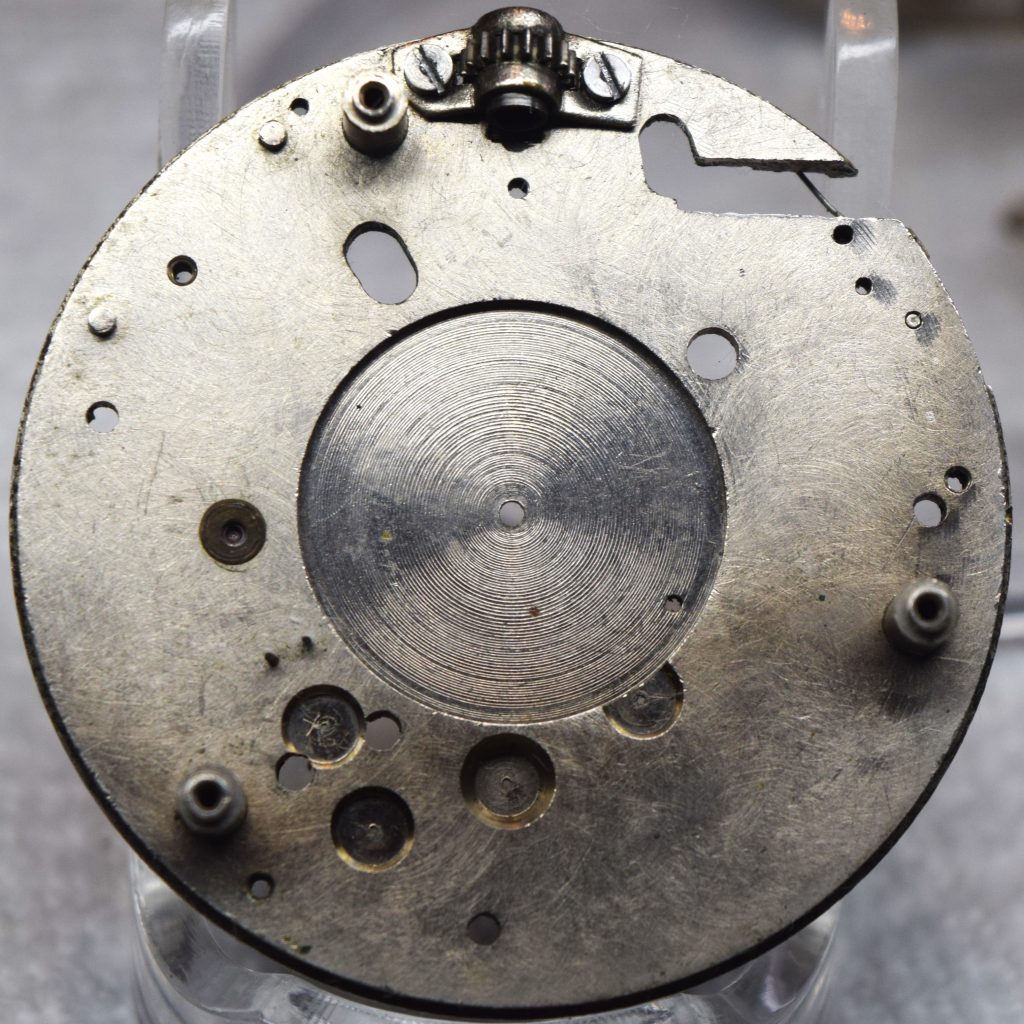

The photos above show the milled channel for the brass setting pin found on the 1896 version of the Companion.



The photos above show the milled channel for the steel setting pin and the milled track for the tear-shaped toggle found on the back side of the pillar plate on the 1906 version only.




The first photo above shows the design of the original 1896 brass setting pin, as well as the stem and crown assembly. You can see that they have compression rings to hold them loosely in place instead of having the set screws found on the 1906 Companion. The second and third photos above show the evolution of the 1896 setting pin and the stem and crown assembly to include making the setting pin out of steel and elimination of the compression rings in favor of set screws. The fourth photo shows the design of the 1906 Companion’s steel setting pin and the stem and crown assembly.



The Companion is the only Seth Thomas pocket watch that is pin set. A cut (woodcut engraving) of the Companion’s image is displayed, and all of its unique components, along with its uncasing procedure, are described in the 1904 Seth Thomas Watch Material Catalog. The same cut of the Companion’s image is accompanied by a description of its unique features in the 1913 Seth Thomas Watch Movements Illustrated Price List. The same cut of the Companion’s image is also used by author Tran Duy Ly in his two-volume book, Seth Thomas Clocks & Movements. Publicly available photographic documentation of the Companion and its component parts is extremely limited. Available period advertising related to the Companion only depicts a front exterior aspect of it. Likewise, comprehensive photographic documentation of the Seth Thomas Tourist is essentially absent from the public domain. I am extremely grateful to be in a position to provide a more complete photographic documentation of these special, unique Seth Thomas timepieces to the horological community.
Initial Inspections & Investigations of Available Companions
The 1906 Version of the Companion – Model 8 – Example #1
My first Companion (serial # 802346) was purchased in relatively good condition and was mechanically complete. A yellowed plastic crystal in a gold-colored bezel covered the heavy Arabic dial equipped with blue spade hands instead of the original railroad hands.



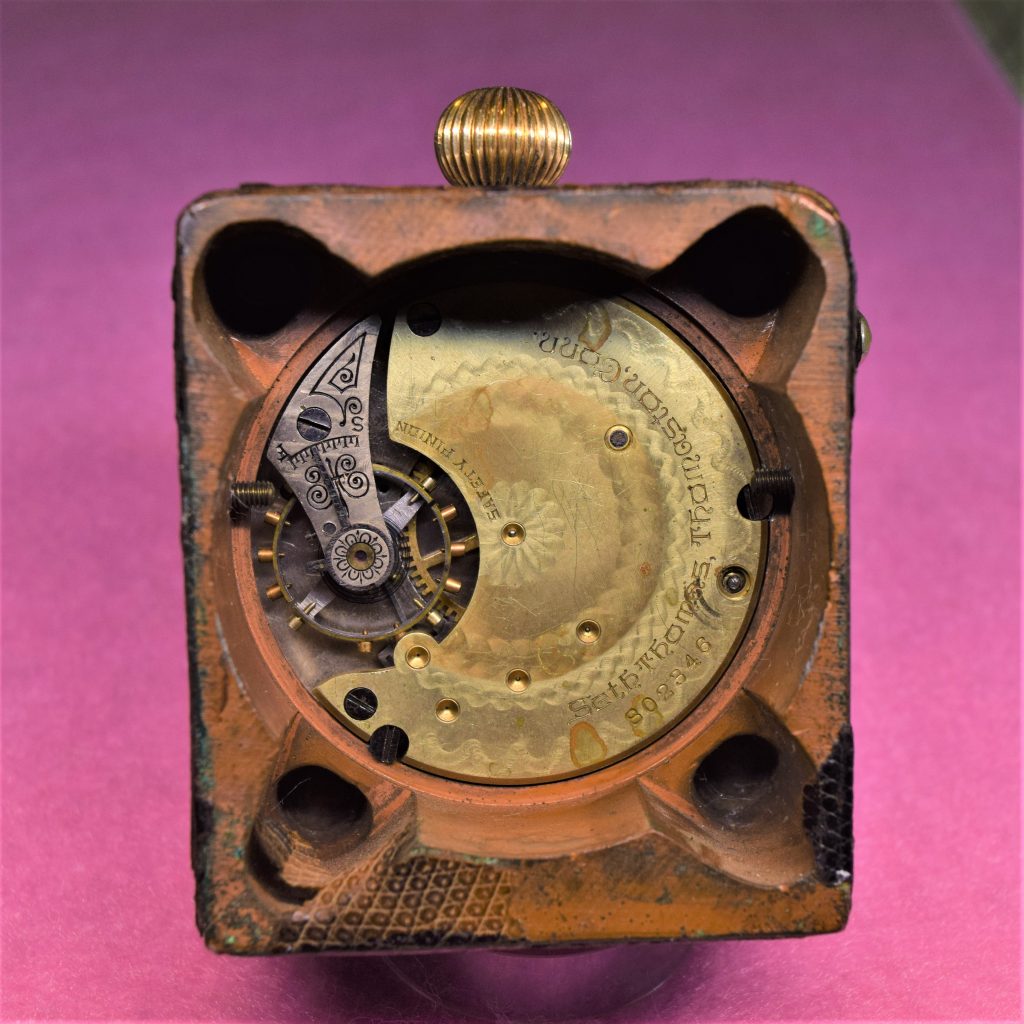


The Companion’s brown lizard leather cover was 95% complete, with only the back pocket structure, which holds the “sliding back cover” in place, missing. The leather-covered brass sliding back cover was present and intact, but there was no clear indication of how it engaged the metal case to serve as a sliding back cover. The adjustable leather carrying strap was also missing. Having such a complete specimen of the Companion was a great aid in developing a good initial understanding of the 1906 version’s structural design and functioning.
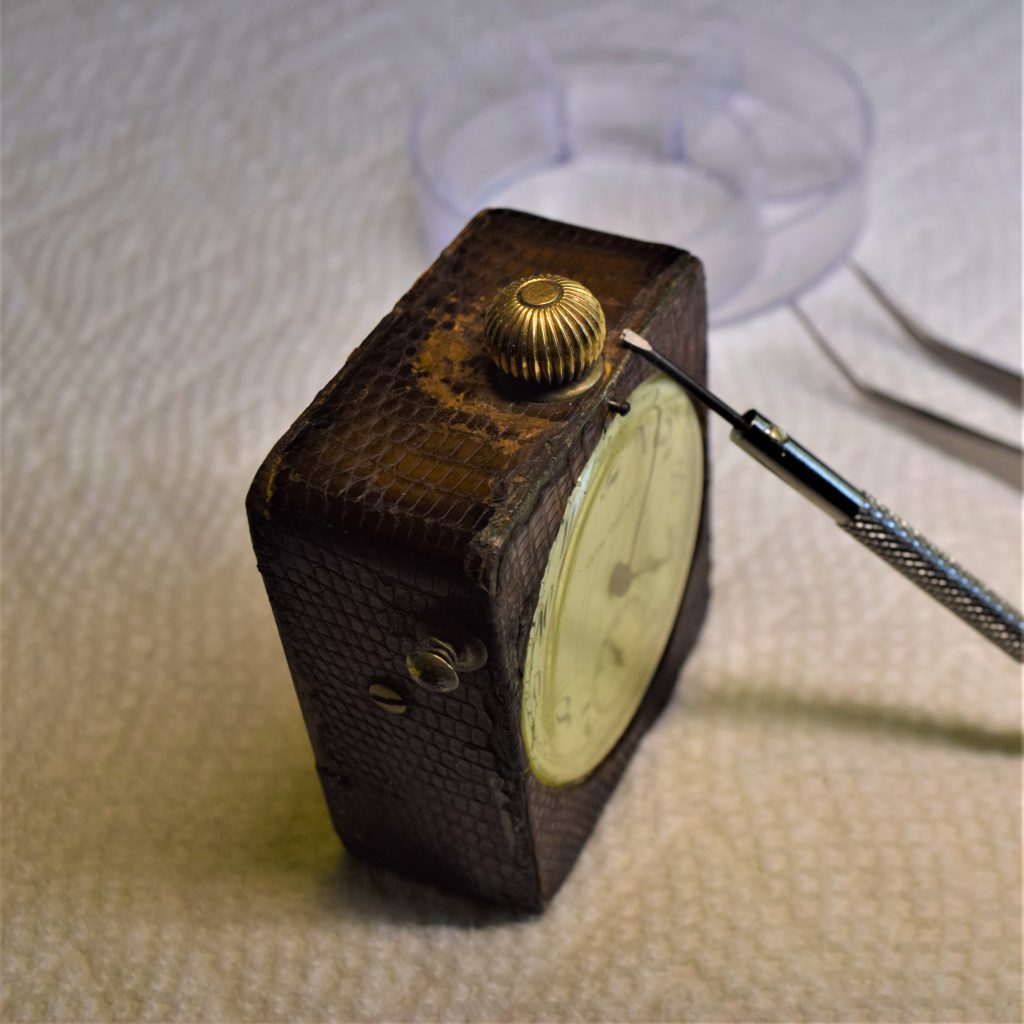







The 1906 Version of the Companion – Example #2
My second Companion (serial # 810984), when purchased, consisted of a mechanism packed with insects and thick dust, a very good heavy Arabic dial, spade railroad hands, and a bronze case that was missing its leather covering, sliding back cover, bezel, crystal, crown, stem, stem bushing, setting pin, and screws for attaching the missing adjustable leather strap.


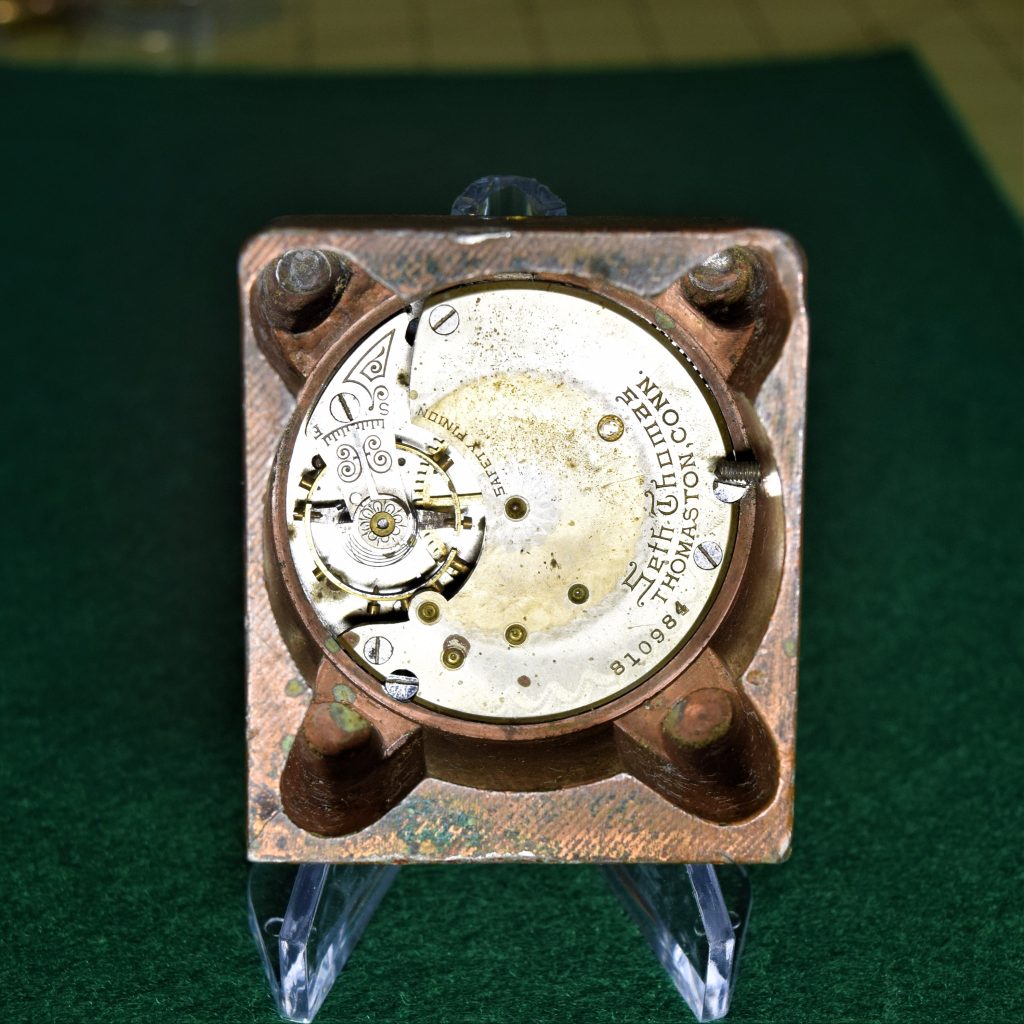

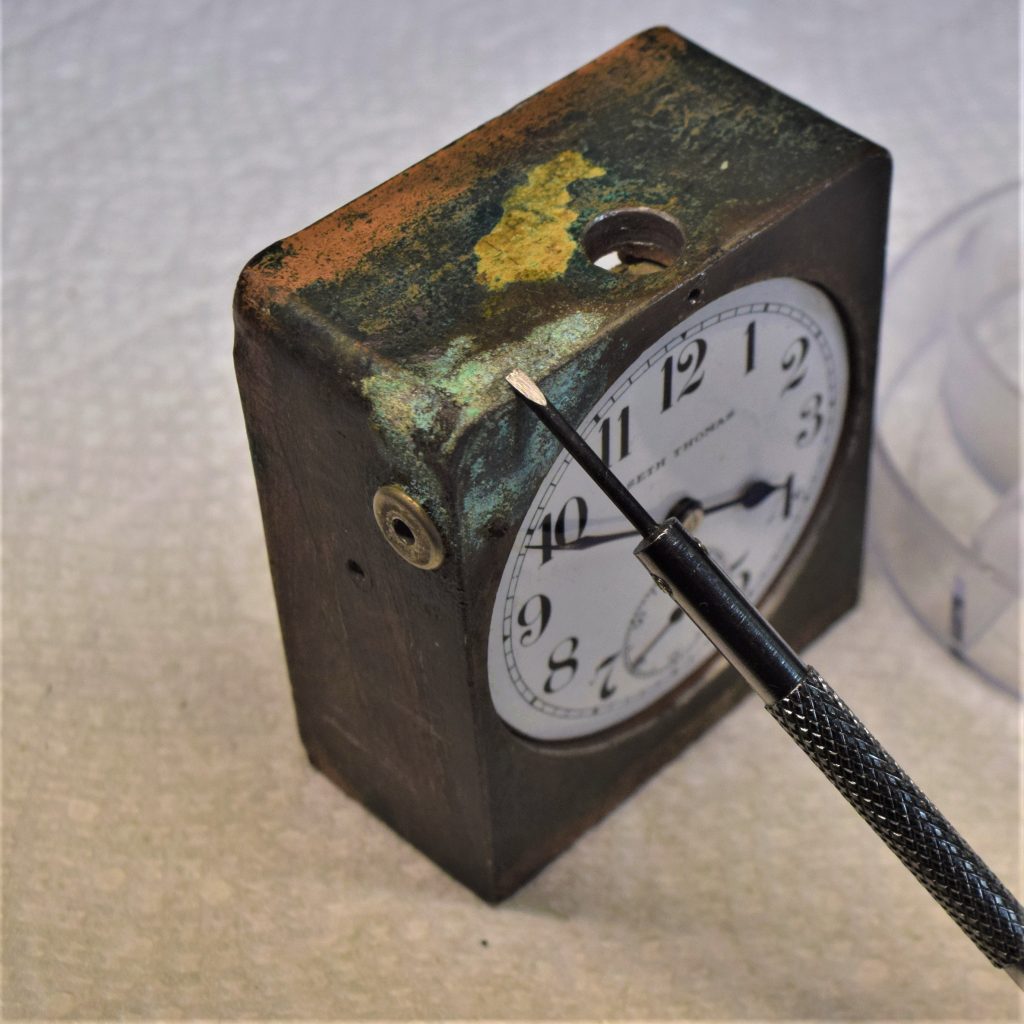


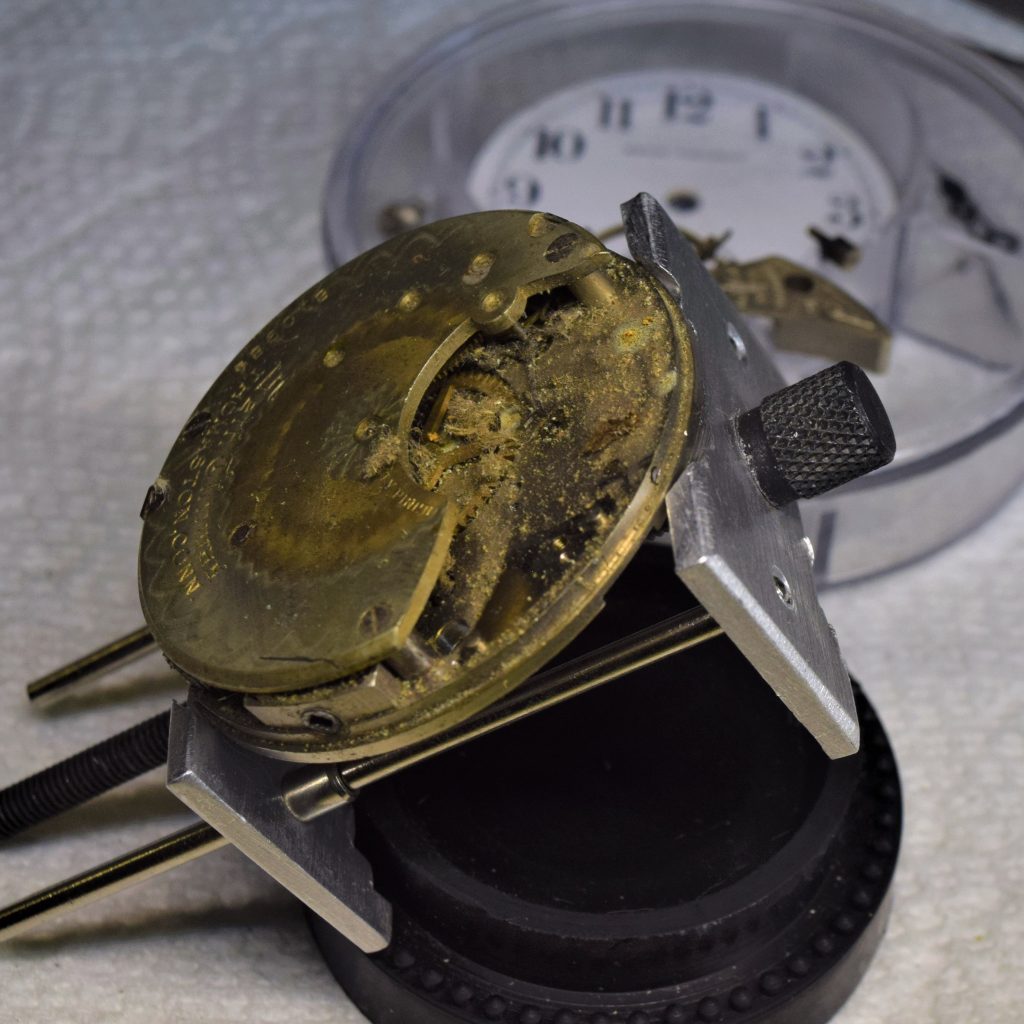
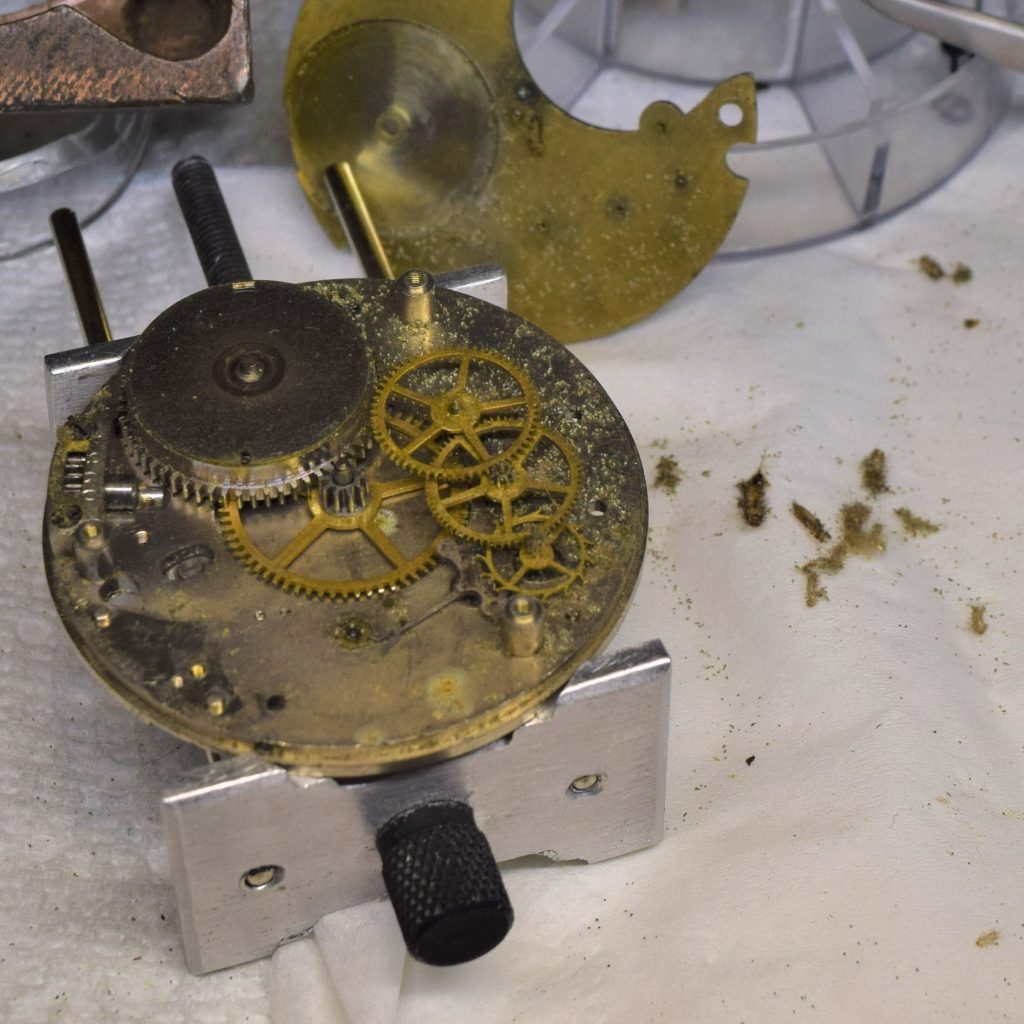



The set screws for the winding stem and setting pin were still present. Having such an incomplete specimen with a compromised mechanism that required complete disassembly was a great aid in developing a better understanding of the bronze case and the interior design and function of the mechanism.
The 1906 Version of the Companion – Example #3
My third Companion (serial # 846647) was purchased 95% complete, missing only the leather covering for the brass sliding back cover and the adjustable leather strap. The back pocket structure, which holds the sliding back cover in place, was intact, permitting full inspection and assessment of the techniques used for its construction and attachment to the metal case. The brown Morocco (levant) leather case was quite worn in places, especially the top, but was intact and complete. The mechanism was in very good condition.




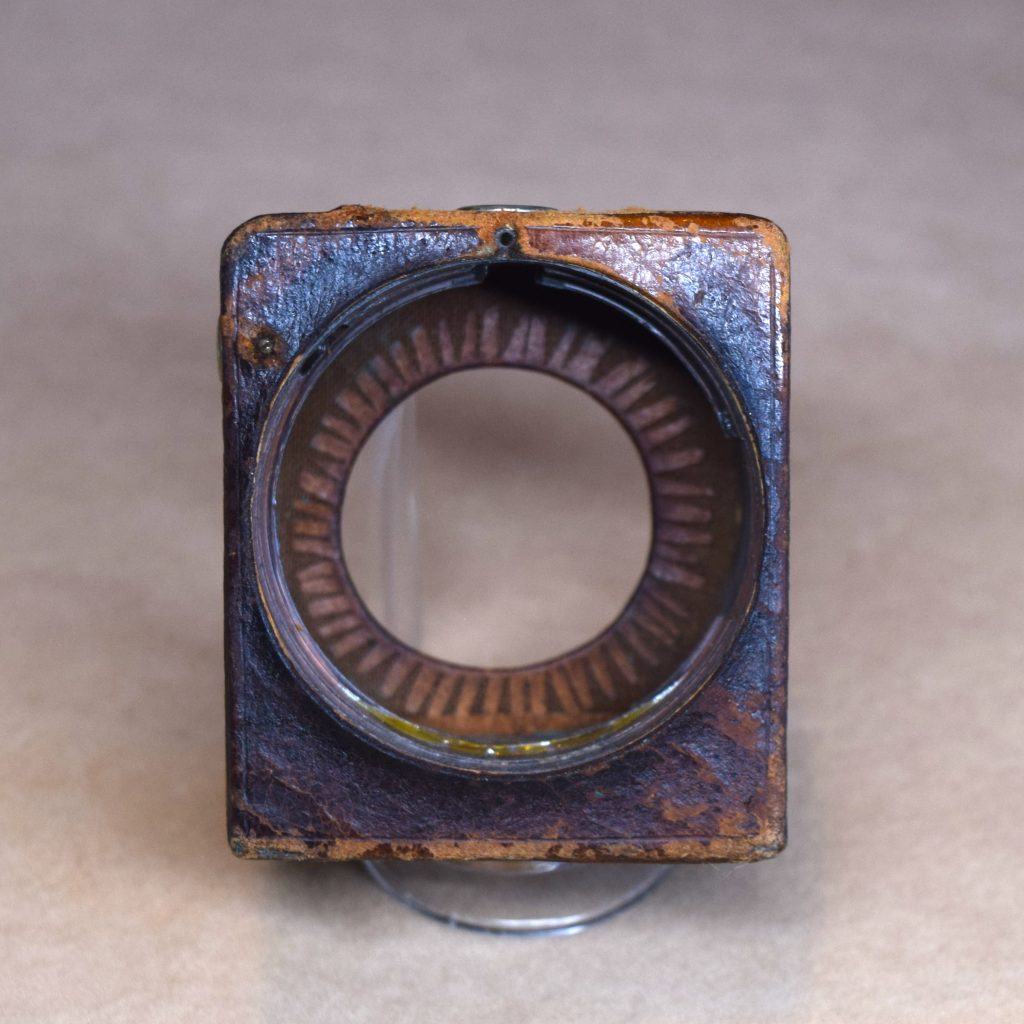




A clear plastic crystal with a thin gold-colored bezel covered the heavy Arabic dial and railroad hands. Having such a complete specimen of the Companion was a great aid to developing a better understanding of its structural design and functioning through the process of comparison with features of my other specimens. Seeing that the same component parts are present in each specimen confirms that these parts were original and standard, not workable replacements installed over the past one-hundred ten to one-hundred fifteen years.
The 1896 Version of the Companion – Model 6 – Example #1
My fourth Companion (serial # 599805) was purchased 99% complete, missing only the leather carrying strap, but there are remnants of the strap still on its anchor screws. The back pocket structure, which holds the sliding back cover in place, was intact. The red Morocco (levant) leather case was quite worn in places, especially the top, but was intact and complete. The mechanism was in very good condition and was outfitted with a heavy Roman dial, railroad hands, clear glass crystal, and a gold-colored bezel.


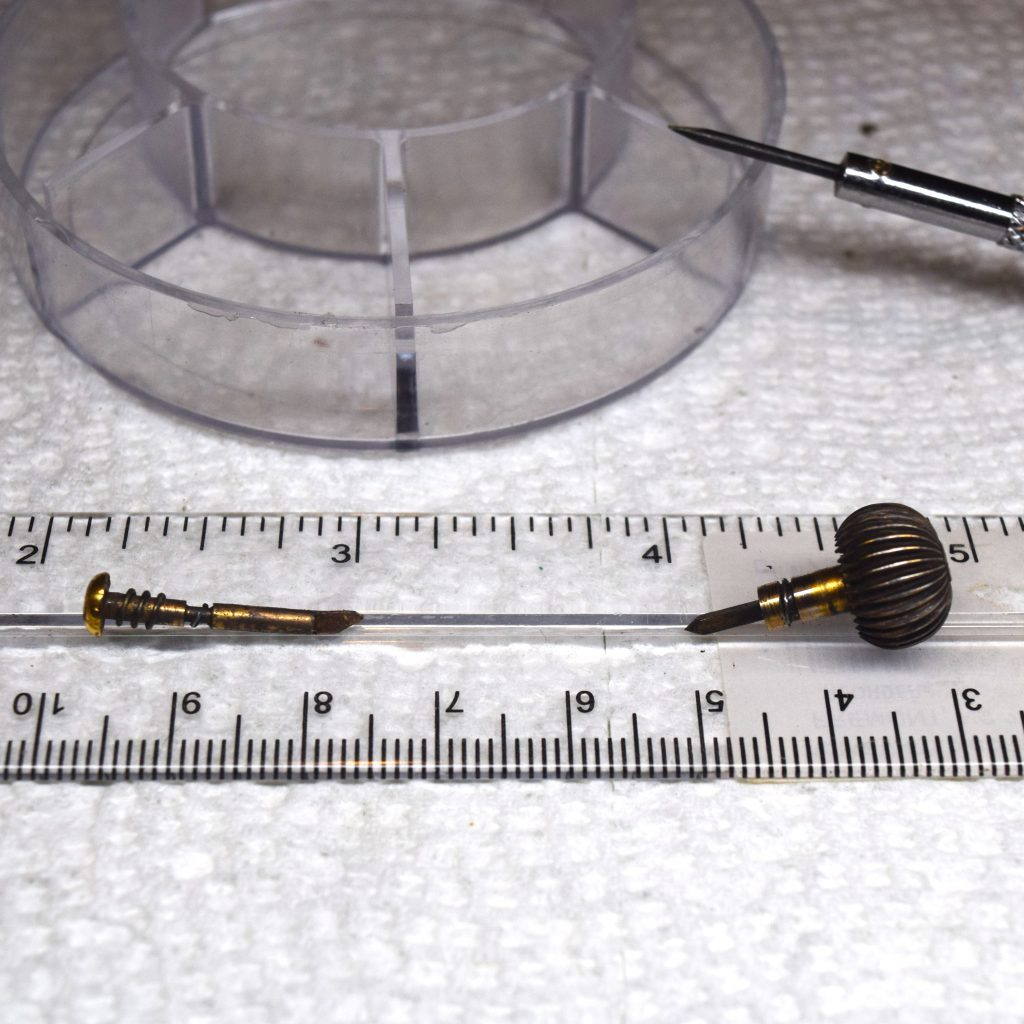
Having such a complete specimen of the 1896 version of the Companion was a great aid to developing a better understanding of its structural design and function, as well as the differences and commonalities between the 1896 and 1906 versions. The setting pins and winding stems are somewhat different between the two versions, and there are no set screws for these components on this specimen of the 1896 version. Instead, they are held loosely in place by compression rings.

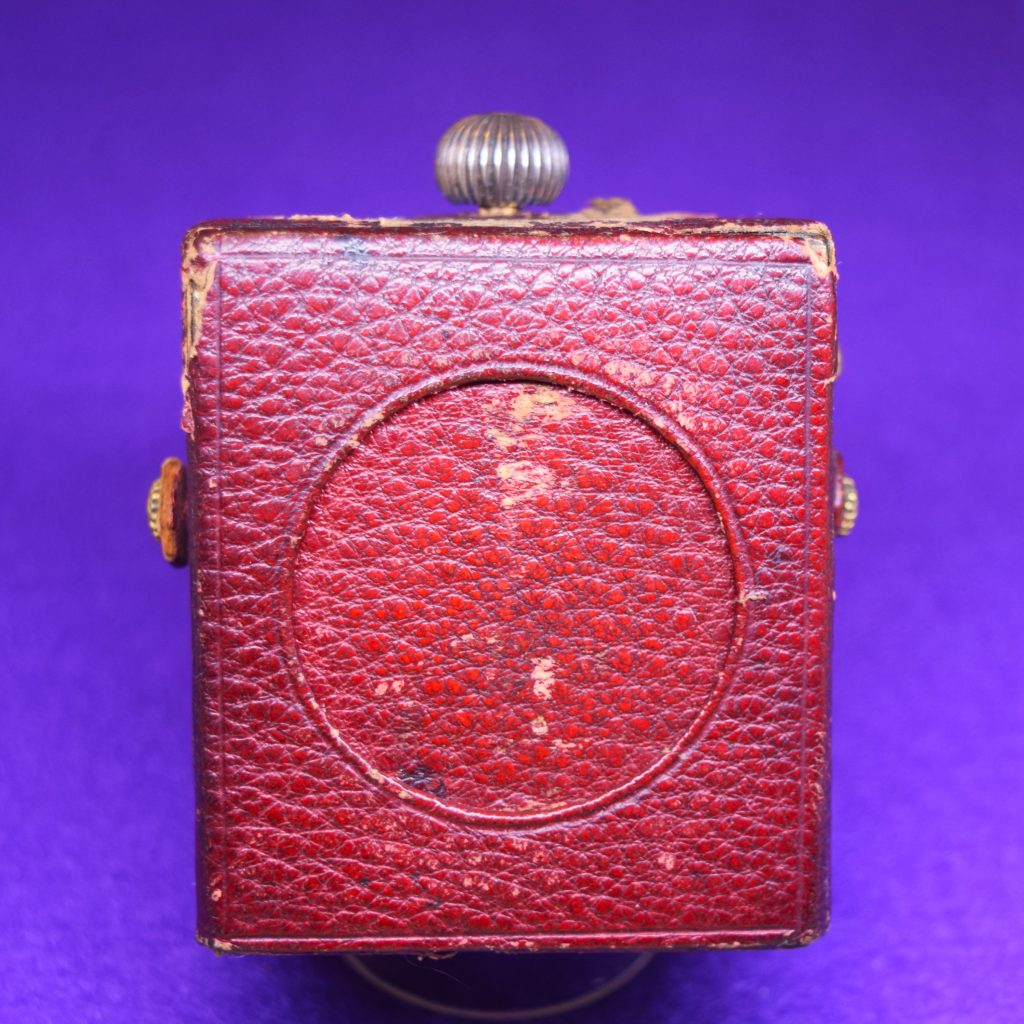

Subsequent Inspections of Additional Companions
After inspecting the first specimen of the 1896 version of the Seth Thomas Companion, some months went by before it became possible to inspect any others. When back-to-back opportunities presented themselves to purchase a second and third specimen of the 1896 version of the Companion, with each appearing to have some obvious features suggesting relevance to further uncovering and documenting the little-known history of the 1896 version, I jumped at both opportunities.
The most significant features that stood out to me from the photos in the online advertisements were: 1) the presence of set screws to restrict movement of the setting pin and the winding stem on one of the specimens. 2) a variation in the dial style. One specimen was fitted with a heavy Arabic dial, different from the heavy Roman dial on my first 1896 version and different from the cut depicted in Seth Thomas Clocks and Movements by Tran Duy Ly. It was the same as those on the four 1906 versions presently in my collection. 3) the top plate on one of the two new specimens is unsigned, as my first specimen of the 1896 version was. This feature raises the question of whether the Seth Thomas Watch Company initially intended for all of the Companion movements to be unsigned or if these two specimens were manufactured early in the production, possibly experimental, test-run, or prototype examples of the Companion. Some examples of the Seth Thomas Companion can be compared on the Pocket Watch Database – Private Label Gallery Search.
The 1896 Version of the Companion – Example #2
Once the first “new” Companion (serial # 605313) arrived, it was a treat to be able to sit down and learn more about it. The photographs below were taken during this first sit-down engagement with the Companion. This Companion was equipped with a very thick glass crystal, surrounded by a gold-colored metal bezel, protecting the heavy Arabic enamel dial and railroad spade hands. The dial had a triangular piece of enamel missing from the numeral “9” which had been replaced with an enamel patch. The patch had fallen out and was loose on the surface of the dial.




The front portion of the black Morocco (levant) leather case was completely missing. The back half was partially missing, patched with electrical tape, and completely detached from the case, but the sliding back cover was present and intact, with damage to only one side. The back pocket structure, which holds the sliding back cover in place, was missing from the detached and crumbling remnant of the case. The adjustable leather carrying strap was missing, as were the screws used to hold it in place. A short section of peg wood was filling one of the holes where these attachment screws were once positioned. There were some patches of leather stuck to the metal case, mainly around the bushings for the winding stem and the setting pin. There was evidence that the metal block case had been covered with printed paper beneath the leather case. The printing seems to possibly be a watch advertisement.










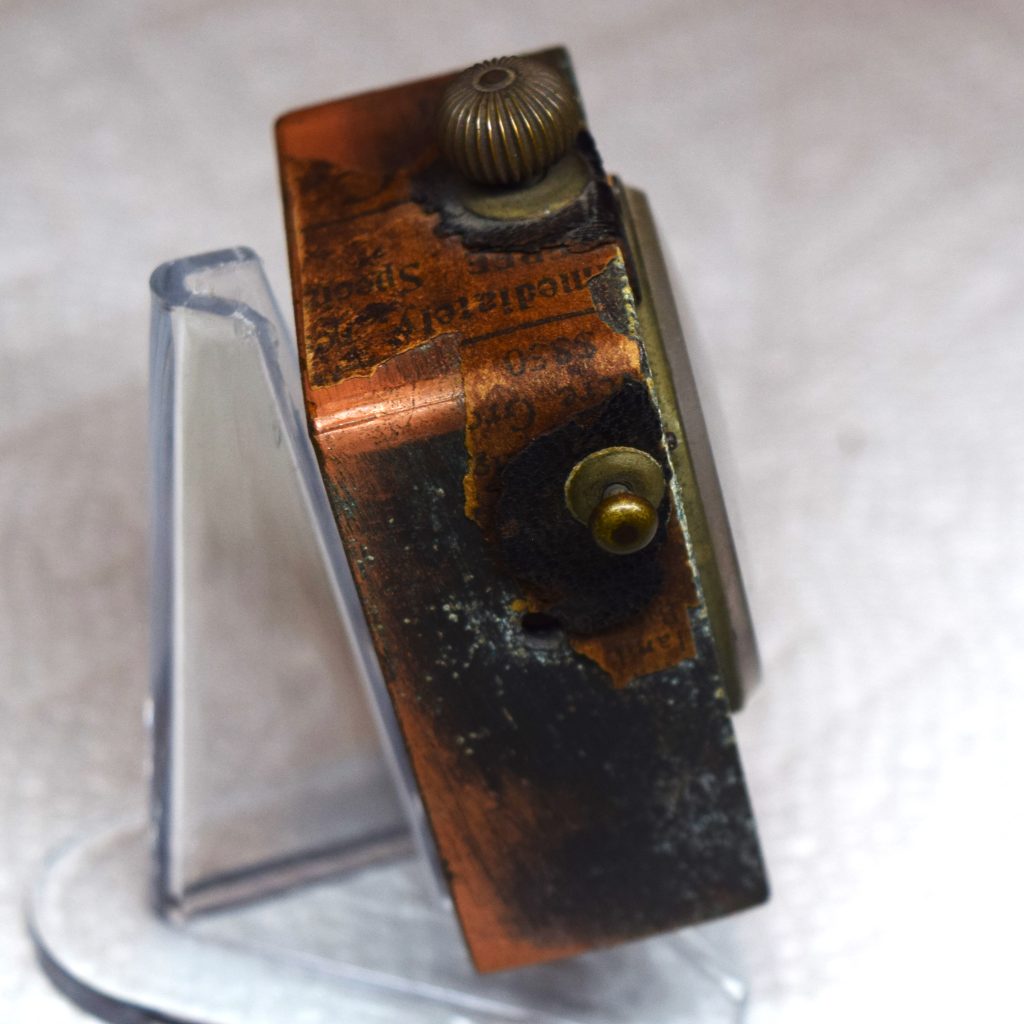


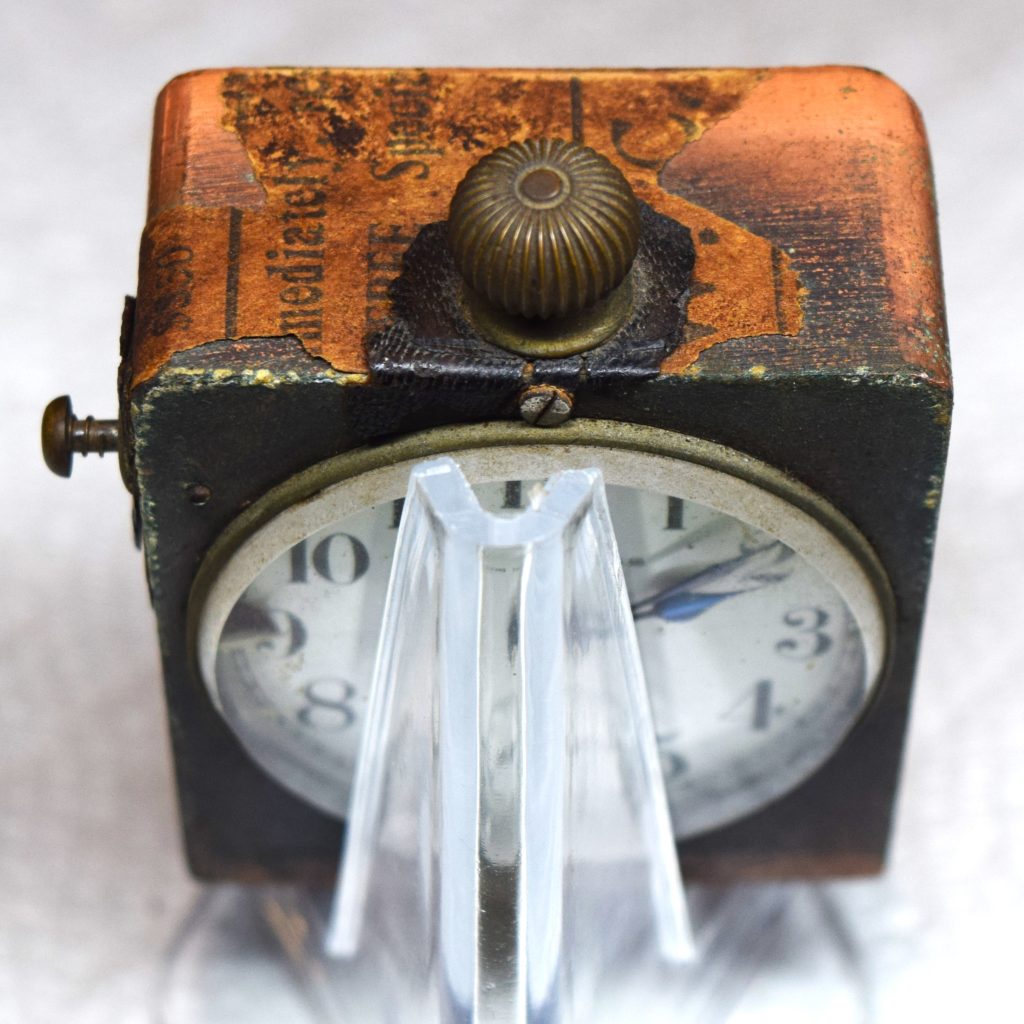


Upon closer examination of the “set” screw being used to stabilize the winding stem, it was apparent that it was a case screw or casing screw, too narrow in diameter to engage the threaded port into which it was inserted. The winding stem and crown were very similar to those found in my other 1896 version of the Companion, but not identical. Upon trying the set screw from one of my 1906 Companions in this case, it fit perfectly and threaded properly into the port.
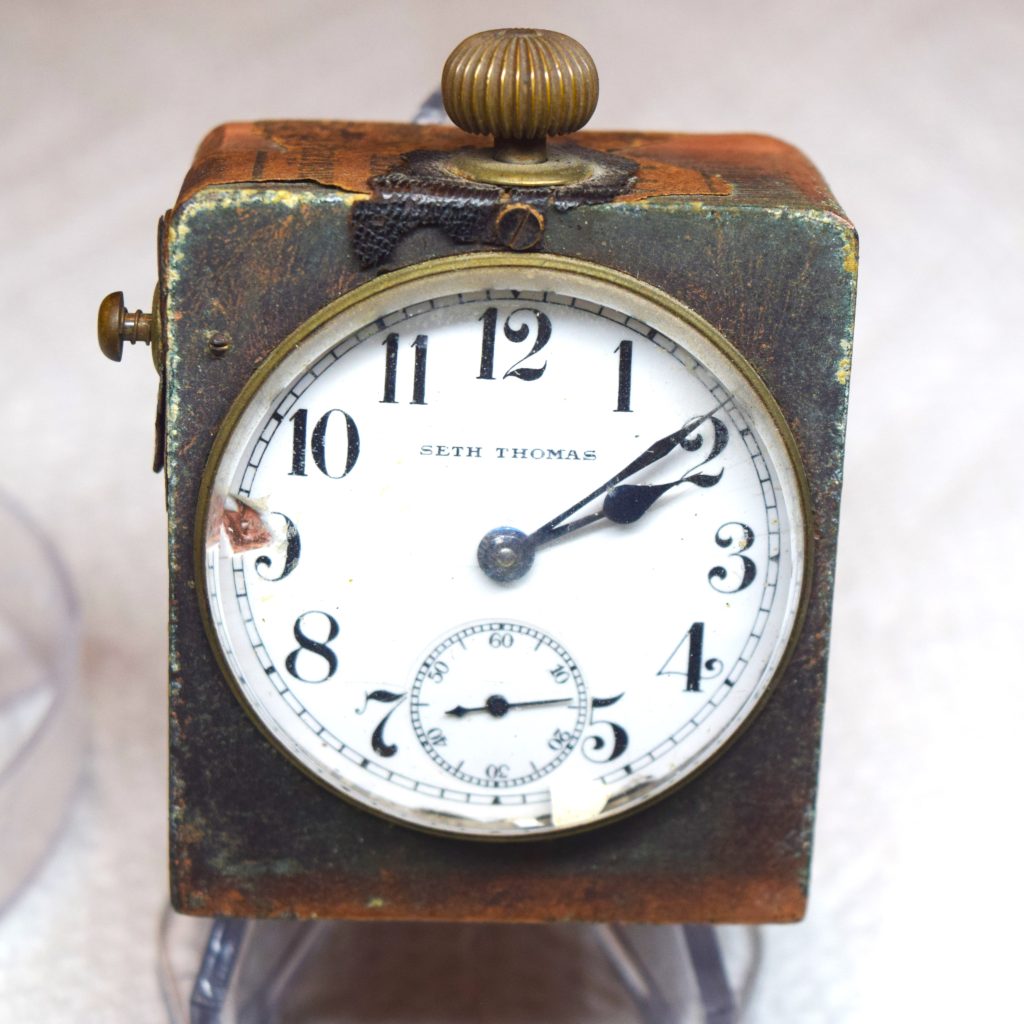

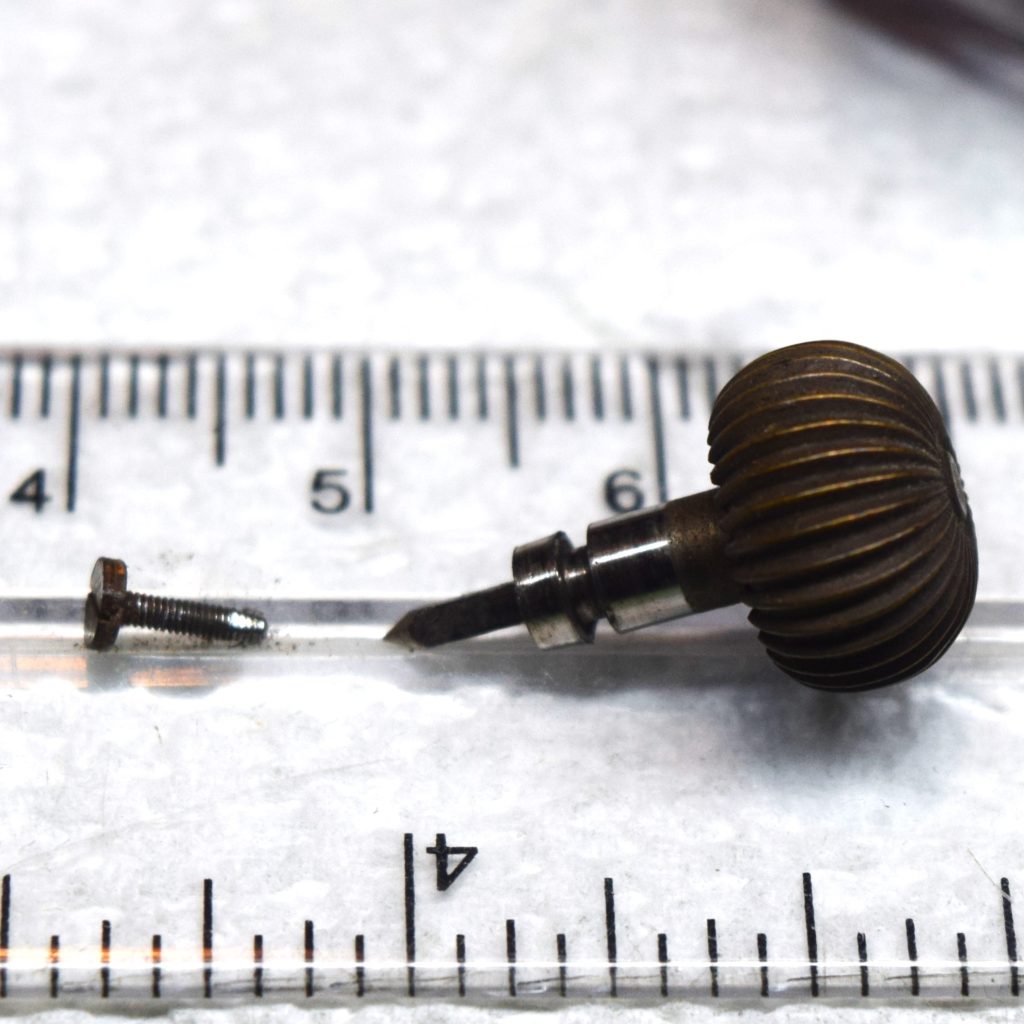

The set screw for the setting pin was the same type of screw as was found in the 1906 specimens in my collection. The setting pin that it stabilizes has a flat side for the screw to engage, and the flat end of the pin is canted to more smoothly engage the intermediate winding wheel to disengage the mainspring winding function by tipping the yoke and engaging the intermediate setting wheel, permitting setting of the hands.






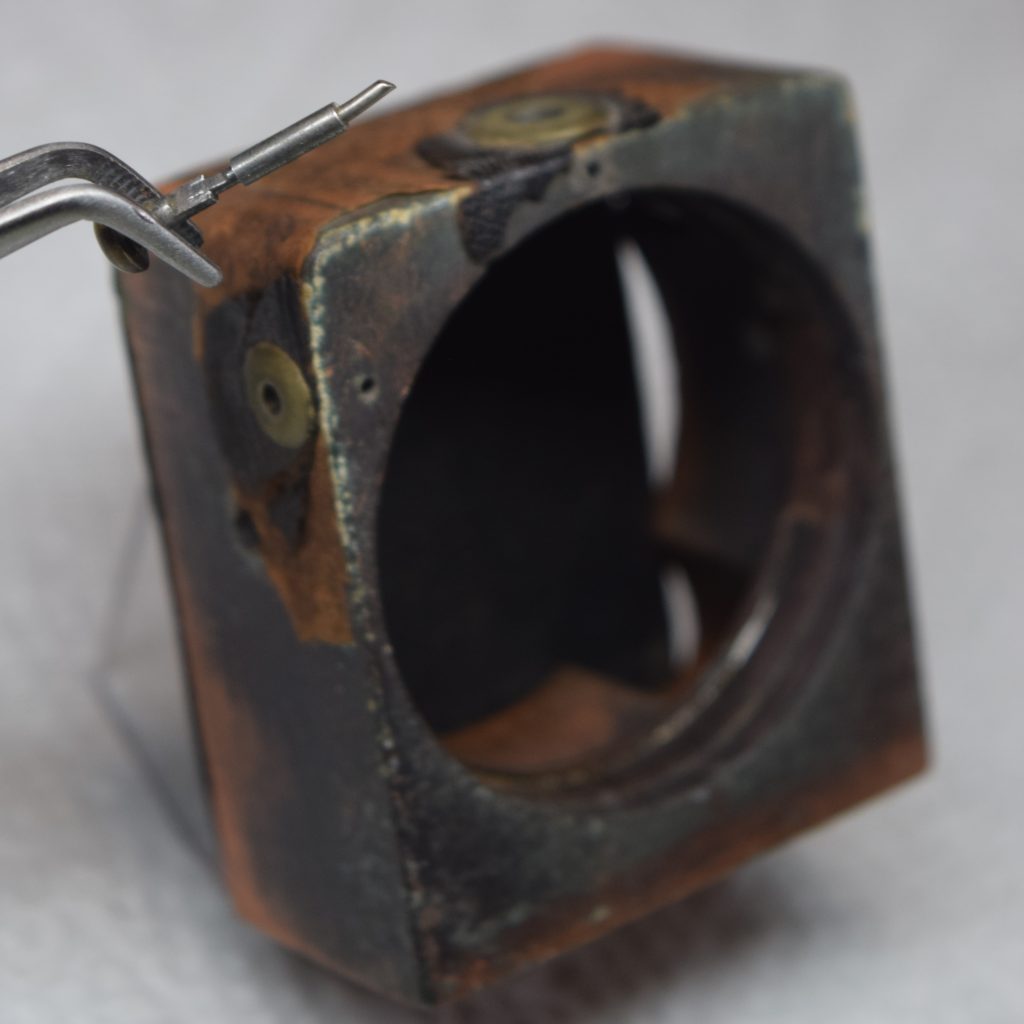
The setting pin that it stabilizes has a flat side for the screw to engage, and the flat end of the pin is canted to more smoothly engage the intermediate winding wheel to disengage the mainspring winding function by tipping the yoke and engaging the intermediate setting wheel, permitting setting of the hands.
The 1896 version of the Companion utilized the Seth Thomas Model 6 movement. In this version of the Companion, there is no special milling on the back of the pillar plate to serve as a track for the tear-shaped toggle found on the 1906 version of the Companion because there is no tear-shaped toggle on the 1896 version. The setting pin directly presses on the intermediate winding wheel, tipping the yoke to disengage the winding wheel, engaging the intermediate setting wheel to move the hour and minute hands, and setting the time. This arrangement appears to have resulted in bending the tip of the early brass setting pin/plunger.
The 1896 Version of the Companion – Example #3
The second “new” specimen (serial # 597683) is a pocket watch movement only, without the Companion metal block case and leather covering and without the setting pin plunger or winding stem and crown assembly. There was no dial, original or otherwise, attached to the movement. There was no usable second wheel pinion protruding through the pillar plate far enough to facilitate a seconds hand. It is unknown whether this was an intentional feature of the movement or due to accidental damage. The ratchet bridge, ratchet, and click were all missing, but the click spring was present. The yoke, main winding wheel, and intermediate winding and setting wheels were all missing, but the yoke spring and its screw were present. It was possible to replace the missing components from other incomplete Model 6 movements that had been previously purchased for this purpose.




Having such an incomplete specimen with a compromised mechanism that required complete disassembly was a great aid to developing a better understanding of the interior design and function of the mechanism, and the specific mechanical differences between the 1896 version and the 1906 version.










The mechanism is in poor condition and it is not running. Because there is no pinion to support a seconds hand a period and model appropriate dial without a seconds bit was placed on this movement. That may have been the original design of this particular 1896 Companion. It matches the cut of the 1896 Companion presented by author Tran Duy Ly in his two-volume book, Seth Thomas Clocks & Movements.




Thoughts on the 1896 Companion
The First New Specimen of the 1896 Version
It is reasonable to believe that the newer “1906-like” version of the Companion’s metal block case was original to the 1896 Companion’s Model 6 movement. The winding stem and crown assembly design is obviously derived from the 1896 version, minus the compression rings. The tip of the set screw occupies the groove that previously contained the compression ring.



Most of the setting pin/plunger design from the early 1896 Companion is carried over into the newer evolved 1896 Companions, and there are also design components that point toward the 1906 Companion’s components. The second version of the pin/plunger is segmented with a canted tip as the first pin was; and it also has the hint of a full cylinder but with a diminished tip, and a dedicated flat surface to engage the set screw.



The evolution seems intentional and solution-driven, improving the connection between the setting pin, the winding stem, and the metal block case while providing a stronger steel setting pin that is less prone to bending inside the mechanism. If we try to explain the use of the Model 6 movement in the newer case with setscrews as transitional, simply using up the parts inventory from the previous version, instead of evolutionary; how do we explain the changes in the setting pin plunger, and winding stem and crown assembly?
It is not possible to discount the possibility that an ingenious horologist needed a replacement case for his 1896 version Companion movement and had to adapt the winding stem and setting pin to work in a 1906 version Companion’s case. The positions of the casing screws in Seth Thomas Model 6 and Seth Thomas Model 8 movements are essentially the same, so an additional set of footprints would not exist to give such a swap away. There is not enough research in the public domain to fully support one conclusion or the other, but I doubt that such an ingenious horologist would have used a casing screw to replace the set screw for the winding stem.
The Second New Specimen of the 1896 Version
In addition to providing the critical perspective that having a third research specimen allows, a feature of particular interest was the top plate being unsigned. This is the oldest of the three 1896 versions in my collection. It bears serial number 597683. The second oldest movement, serial number 599805, is also unsigned. This raises the question of whether the Seth Thomas Watch Company initially intended for all of the Companion movements to be unsigned or if these two specimens were manufactured early in the production, possibly experimental, test-run, or prototype examples of the Companion. Unsigned pocket watch movements are very rare in the Seth Thomas product line and draw justified scrutiny. “Unsigned” in this context means that these movements are not signed with the Seth Thomas brand name, with a Private Label name, or with an engraved Rose or an Eagle. Without a larger sample of Companions to examine directly or other documented public domain research to reference, it is difficult to support any specific conclusions that examination of this small sample of Companion specimens may suggest or point to.
Closing Observations & Conclusions on the Companion
A General Observation/Conclusion
This study of the Seth Thomas Companion is by no means complete or definitive. My exploration of the 1896 and 1906 versions of the Companion included only a very small sampling of the entire production. The observations made through this exploration provide an initial data set that may be used by others to provide further observational input and expand our understanding of this special, unique Seth Thomas timepiece.
The 1896 and 1906 versions’ leather-wrapped cases are 2 ¼ inches tall (not including the crown) by 1 15/16 inches wide by 1 inch deep. The metal in the 1896 case seems to be of a higher grade brassy material. In Seth Thomas Clocks & Movements the 1896 version has been depicted with an unsigned heavy Roman dial with no seconds bit, and with spade railroad hands. There is no mention in the description whether an Arabic dial was available for this version, or whether it was available with a seconds bit. Specimens within this exploration point to the availability of each of those options.
The exact steps in the evolution of the Companion Travel Timepiece, manufactured by the Seth Thomas Watch Company, between its two versions are not very clear. A small sample of evidence does point to evolution of the 1896 version’s setting pin plunger toward the 1906 version’s setting pin plunger. This small sample of evidence also points to an evolution in the use of the metal block case with set screws in the 1896 version as well as the 1906 version. A small sample of evidence also points to evolution in the milling of the pillar plate from being milled on one side in the 1896 version to being milled on both sides with the addition of a tear-shaped toggle to facilitate the pin set feature. There is no public domain research that identifies any 1896 version specimens with the tear-shaped toggle yet, but we’re working on it.
The importance of making historical background information freely available to all who have an interest in the roots of the American clock and watch industry cannot be overstated. Information that is not freely shared not only confounds the research of present-day horologists but will likely become information that is forever lost to future generations of horologists.
The Pocket Watch Database, serving as a collective repository for the studies and research of many, is playing the greatest role in collecting, organizing, consolidating, and freely disseminating invaluable information to the horological community and the public at large.
A Traveler and a Tourist

A Traveler
There is also a similar Seth Thomas product named the Traveler in a similar but slightly larger, 3½ inches high, glazed leather-covered metal block case with a nonadjustable leather strap.
It appears that the Traveler incorporated the Seth Thomas Model 4, key wound, and key set movement into its design since there is no visible crown and stem protruding from the case and no pin or other mechanism to facilitate setting as it is depicted in Seth Thomas Clocks and Movements by Tran Duy Ly. Further evidence that the Model 4 was used is the description of the movement as a “one-day lever”, and that the bezel appears to be different from the type used on the Companion possibly to facilitate frequent removal as would be necessary with a key set movement. The Traveler is depicted with a standard, not heavy, Arabic dial and standard spade, not railroad, hands, making it more difficult to see from a distance.
Tran Duy Ly chose to include the Companion and Traveler in the section of his book where he describes Seth Thomas carriage clocks instead of the section on watches where he describes the third Seth Thomas travel timepiece, the Tourist.
A Tourist

The Seth Thomas “Tourist” was a folding leather travel timepiece made in two overall versions, one containing a 12-size Seth Thomas Centennial movement and the other containing a 16-size Seth Thomas Centennial movement. Each was contained within a pocket-sized 2 1/2-inch by 3 1/4-inch leather case/stand. Sitting in a pouch within this case/stand, the 12-size Centennial movement was fitted with a traditional pocket watch dial and case. It peeked out from behind through a hole in the leather wall that positioned it in a somewhat vertical orientation. The 16-size movement was fitted with a specialized conversion dial and a case that would grasp the leather stand by screwing the bezel down upon the leather around the hole in the leather wall through which the male threads of the case protruded.
EA 822 – Centennial – 12-size – Serial Number 3280055 – 7 jewels




Aside from their being fitted with heavy railroad hands, it is not possible to know which 12-size Centennials were deployed within the ranks of the leather-cased Tourist travel timepieces unless they are still paired with the leather Tourist case/stand. Inside the leather case/stand, the 12-size Tourist movements were cased normally like any other 12-size Centennial pocket watch. No photographs of the 12-size Tourist travel timepiece are publicly available in its leather Tourist case/stand. The 12-size watch could readily be removed from the leather case and be used as a standard conventional pocket watch.
It is easier to identify which 16-size Centennials were deployed within the ranks of leather-cased Tourist travel timepieces despite their being separated from their leather stand/case. The 16-size Centennials that were used in the Tourist travel timepiece had a conversion dial that placed the winding stem at 6:00. They also had a Nickel Silver case, manufactured by Illinois Watch Case Company, that had a snap back cover and a screw bezel. The bezel was slightly larger than the case body and its threads left a small gap in which it could gain a grip on the leather case that it overlapped. Other differences in the specialized watch cases were a squared pendant without any attachment points for a bow and the lack of a bow. No photographs of the 16-size Tourist travel timepiece are publicly available in its leather case/stand.




The photos above show: the Ehrhardt American Numbered Drawing for the 16-size Centennial; the gap in the specialized case where the bezel screws down to grip the leather case/stand; the 16-size Tourist case/stand that allows access to the crown for the watch to be wound and/or set from the 6:00 position; the squared pendant on the specialized case. There are no attachment points on this pendant for a bow.




Awesome read on these beautiful Seth Thomas watches. I really enjoyed this very thorough study.
thank You
Kind Regards
Jim
Thank you!!
There is so much more to do on this project.
All in good time I guess.
Wonderful article and illustrations/photos by Mr Jonathan Luysterborghs .As an admirer of Seth thomas watches very much appreciate the article and the excellent site run by Mr Nathan Moore a credit to us collectors and horology…. Thankyou gentlemen !!
Thank you, Barry!!
I still have another handful of them to take apart and compare to the earlier ones.
Who knows what will emerge?